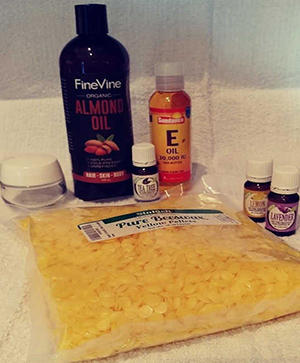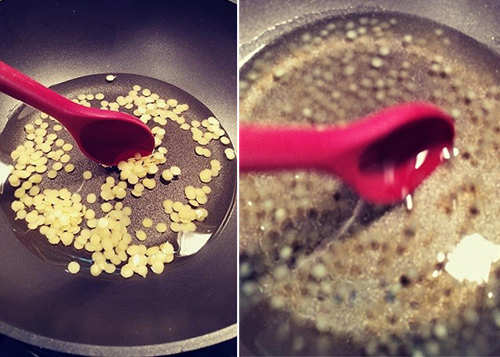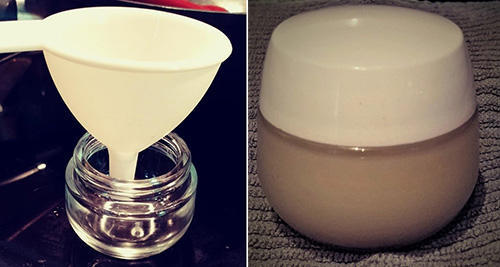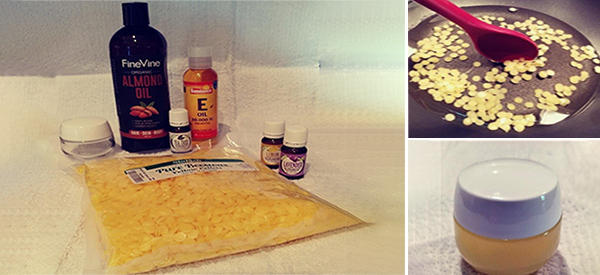There are several OTC antiseptic ointments to choose from at the local market, which are normally applied directly to the wound. They are meant to prevent infection from developing. While these options often work and the products have some helpful ingredients, they also have some unnecessary ingredients, so they can be mass produced.
Fortunately there is an alternative for those of you who choose to live a more natural life, without the unnecessary added ingredients to every day products. This isn’t about saving money, because to be honest, the ingredients are not necessarily inexpensive for the initial purchase. On the other hand they will last a very long time and make several batches of antiseptic. Or, you can share by making this for family and friends who also want to benefit from a purer approach to healing.
Making the Ointment
The recipe we are sharing is packed with anti-germ properties, which will aid in keeping a minor wound from becoming infected. It will also help in reducing any possible scarring.
The ingredients are well-known for their healing tendencies, as well as their effectiveness at fighting off infections. So, combining them into a natural homemade ointment to have on hand just makes sense.
 Here is the list of ingredients you will need:
Here is the list of ingredients you will need:
- 5 oz beeswax (pellets melt quicker)
- 1 cup almond oil (could replace this with olive or coconut oil)
- .25 teaspoon vitamin E oil
- .5 teaspoon tea tree oil
- 20 drops of lavender essential oil
- 10 drops of lemon essential oil
Related: 14 Powerful Natural Remedies For A Sinus Infection
But, before we discuss the steps in making this ointment, it’s good to know why each of these ingredients is important:
- Lavender Essential Oil: Lavender not only soothes, but also works as a pain reliever, antibiotic, anti-viral, anti-fungal, and antibacterial.
- Tea Tree Oil: This oil is known for its anti-fungal, anti-viral, antibiotic, and anti-bacterial properties.
- Lemon Essential Oil: Lemon oil acts as an antibiotic, anti-viral, anti-fungal, and anti-bacterial.
- Vitamin E Oil: This oil aids in healing the skin and reducing any scarring that might occur from a minor injury.
- Almond Oil: Some people have found that almond oil has helped heal breakouts of various skin conditions.
Now that you know how each ingredient contributes to making this ointment work, here are the easy directions to putting them all together in creating a healthy and useful antiseptic ointment:
#1. In a small pot, melt the beeswax and almond oil on a very low heat setting. #2. Once that has melted, take the pot off the heat source.
#2. Once that has melted, take the pot off the heat source.
#3. Add the tea tree oil, vitamin E oil, lavender oil, and lemon oil, stirring with a wooden spoon. #4. After the mixture is blended, pour it into a small and sterilized container, and let it cool.
#4. After the mixture is blended, pour it into a small and sterilized container, and let it cool. #5. When it’s cooled down, store in a cool and dark place.
#5. When it’s cooled down, store in a cool and dark place.
That is all there is to it – a very simple way to make an ointment for minor wounds. If you experience a minor cut, scratch or abrasion, dab a little bit of this ointment on the wound a couple times a day until it is healed.
This ointment has a shelf life of about five years.
On a side note, for those who do not like the smell of lemon or lavender, you can substitute either one, or both. Lavender can be replaced with chamomile essential oil, and lemon can be replaced with fir essential oil.
You may also like:
 30 Most Popular Herbs for Natural Medicine
30 Most Popular Herbs for Natural Medicine
5 Superfoods Of The Ancient Incas, And Why You Should Try Them Now (Video)
21 Wild Edibles You Can Find in Urban Areas
How to Make Ginger Oil To Counter Prostate, Ovarian and Colon Cancer












What are the respective shelf lives of the various oils, especially the vitamin E? Also what are ball-park prices for each ingredient?
This info is useful after SHTF if ingredients are still active and Neosporin is not available, but since an unopened tube of Neosporin should still be effective several years after its expiration date, it might be cheaper just to stock up now.
Especially since dollar tree carries a generic version, where each tube cost only $1.
I found that a large dairy goat of mine had injured his leg/muscle, and had a deep gash. The wound was proud… I cleaned the wound well, and packed it with sugar-honey and wrapped it up with horse leg wrap stretchy bandage ( way cheaper than first aid kind). The swelling in the leg went down and he healed so nicely. When his bandage was loose- he’d find me and offer his leg…smart boy!
Bacteria can’t grow in a sugar or honey environment.
You can get gauze roll bandages, the wrap tape and a bunch of the other supplies at most dollar trees for $1 each. It means even people on a budget can afford to prepare for SHTF.
This isn’t neosporin as labeled in the title “How To Make Neosporin – DIY Easy Tutorial With Pictures”.
A substitute, sure, but NOT neosporin. ?
Neosporin is the brand name for an over-the-counter drug
neosporin is a brand name for the ingredients used. the same properties as listed above.
I have always just cleaned out the wound and then poured in cayenne powder. It stops active bleeding and seals wounds too. And it has a side benefit of preventing scars. I once sliced off my entire nail bed and part of my finger pad with a mandolin slicer. There was no stopping the bleeding. That is, until I dipped my finger into cayenne. It stopped bleeding within a minute or two, sealed off the site. I then wrapped it in gauze and left it for a few days being sure to keep it dry and undisturbed. It never got infected, the nail and finger grew back and no evidence any injury ever took place. Have used this many times on different wounds with the same result and it doesn’t seem to matter how old the cayenne is either. The jar I grabbed that day had been around for a good 20 years. Note it can sting a bit sometimes on an open wound but it’s worth it. Disclaimer: I am not a medical professional and this is just my personal experience. Cheap quick effective and readily available method.
Except that the Neo part is for neomycin, and antixbiotic, missing from the nice salve in this article.
(Misleading title!)
Nice!
Thanks for the info!
OMGosh–I cut a huge part of my thumb with a slicer too>
I used cayenne pepper and it healed well…and as you wrote, it stopped the gushing blood instantly.
I was afraid of starting the bleeding again and didn’t even cleanse with water!!!!
Neosporin and related products in independent trials are no more effective than cleaning with soap and water and applying vaseline, so the given formula is at least as good as Neosporin, possibly better.The serious problem from minor wounds is Staph infection, which is not common but is also not prevented by OTC products like Neosporin. Modern antibiotics like Penicillin have been around for a hundred years and change, before that hospital infection wards were truly a nightmare from Hell.
Not quite 100 years yet, but almost. sulfanilamide preceded penicillin by a few years. Sulfa was the most common lifesaver in WWII. Medical corpsmen would saturate a wound site with sulfa powder. In the 50’s the first aid pouch that every Marine carried as part of his 782 gear included a small package with what looked like a sanitary napkin impregnated with sulfa powder.
I had a mersa infection two years ago and the antibiotic that was prescribed for that infection was sulfanilamide. That was a huge surprise to me that such an old antibiotic was still being used. The doc said that it was the only antibiotic useful against a mersa infection.
Dilute carbolic acid was the first antiseptic used by Joseph Lister in his campaign to get the medicos to clean up their act. Within the past year I read a book about Lister and his struggle with the mind-numbing reaction of the medical folks to his efforts to bring sterile methods to the field.
Hey Left Coast Chuck, What was the name of that book? I am making the assumption that the guy named Lister is the same of Listerine fame. I tried looking for a book about Lister in Amazon and apperantly there is an author named John Listor who is pretty prolific. sounds like an interesting read. Thanks.
??
Which trials? I think this is pure BS.
From Wikipedia: “Penicillin was discovered in 1928 by Scottish scientist Alexander Fleming. People began using it to treat infections in 1942.
melt 1 cup good loe BAG BALM in the green can add 2 tsp colloidal silver and 1 tsp oil of oregano in a double boiler stir well add to empty container chill and adgitate while mixture congeals clean wound apply ointment cover heals wounds in about three days am diabetic worked in a sheet metal factory lots cuts no infections or scars
Does it need to be stored cold , after it congeals?
Can you put it back into the tin the bag balm came from?
Thanks for the post.
Is there an option to replace the lavender oil? My son and I are both allergic.
The article said you can substitute chamomile for lavender
What could substitute for tea tree oil and lavender essential oil? I have severe breathing allergies and am allergic to both of these oils.
Lemon and Chamomile
Tried the recipe and the outcome was very -very- thick, almost candle consistency. It seems like the beeswax (listed at 5oz) is waaay too much. Looking at other recipes online I’m wondering if the ‘5oz’ is a typo.
Yes. I would only use 1oz per cup. It makes it creamy. Five ounces way too much
Broken angel do you work at the dollar store? : )